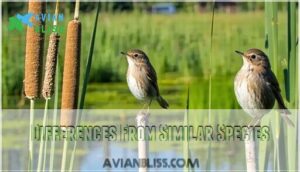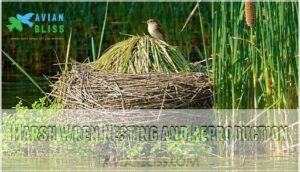This site is supported by our readers. We may earn a commission, at no cost to you, if you purchase through links.

This energetic songbird clings vertically to cattails in wetlands across North America, holding its tail upright like a tiny sentinel.
Males deliver persistent rapid-fire trills that vary by region—western birds sound harsher than eastern ones.
They’re secretive creatures, darting through dense marsh vegetation while hunting insects and small invertebrates.
Despite their elusive nature, marsh wrens are thriving with populations up 130% since 1966.
These fascinating birds build multiple dome-shaped nests suspended above water, with complex breeding behaviors that reveal surprising adaptations.
Table Of Contents
- Key Takeaways
- Marsh Wren Identification and Physical Traits
- Marsh Wren Habitat and Distribution
- Marsh Wren Behavior and Song
- Marsh Wren Nesting and Reproduction
- Marsh Wren Conservation and Interesting Facts
- Frequently Asked Questions (FAQs)
- What is a marsh wren?
- Why is it called a long billed marsh wren?
- What is the difference between a marsh wren and a Western W Ren?
- What does a marsh wren sing?
- How do I see a marsh wren?
- Where do marsh wrens live?
- What are some interesting facts about the Marsh Wren?
- How can I attract Marsh Wrens to my yard?
- What does a marsh wren look like?
- Is a marsh wren a non-breeding bird?
- Conclusion
Key Takeaways
- You’ll identify marsh wrens by their compact 4-5 inch bodies, rusty-brown plumage, and distinctive white eyebrow stripe that cuts across their dark faces
- You’ll find these secretive birds thriving in cattail and bulrush marshes across North America, where they cling vertically to vegetation with their tails held upright
- You’ll hear their rapid-fire gurgling songs and trills echoing through wetlands, with western populations producing more complex melodies than eastern birds
- You’ll discover they’re conservation success stories with populations up 130% since 1966, despite being elusive architects that build multiple dome-shaped nests suspended above water
Marsh Wren Identification and Physical Traits
You’ll recognize a Marsh Wren by its small, plump body and distinctive white eyebrow stripe that stands out against rusty-brown plumage.
These secretive birds hold their short tails vertically while clinging to cattails, making them easier to spot once you know what to look for, with their distinctive white eyebrow stripe being a key identifier.
Size, Shape, and Plumage
You’ll spot the marsh wren’s compact body size immediately – these plump little birds measure just 4-5 inches with a 6-inch wing span.
Their reddish-brown feather color creates perfect camouflage among cattails, while their thin beak shape helps them snatch insects from tight spaces.
The bird’s round shape and short wings give it that distinctive "bouncy ball with a tail" appearance that makes identification easier, with a compact body size and reddish-brown feathers.
Distinctive Markings and Features
You’ll recognize a marsh wren by these striking field marks that separate it from other small birds:
- Prominent white eyebrow stripe – cuts sharply across the dark face
- Black-and-white streaks – create distinctive patterns across the rusty-brown back
- Dull black crown – completely unstreaked, contrasting with the streaked body
The rusty-brown wren’s facial markings create an unmistakable pattern, while its thin beak shape perfectly suits marsh living.
Understanding bird identification techniques is essential for distinguishing between similar species.
Differences From Similar Species
You’ll distinguish marsh wren from similar species through key physical traits.
Sedge wrens are smaller with shorter bills and streaked crowns, while marsh wrens have longer bills and solid black crowns.
House wrens lack the distinctive white eyebrow stripe that makes marsh wren identification straightforward.
Size variations and bill length differences help separate these wren species in bird taxonomy comparisons, using key physical traits to ensure accurate identification.
Regional Variations and Subspecies
You’ll find fascinating regional differences across North America’s Marsh Wren populations.
Eastern subspecies display rustier, more vibrant plumage compared to their western counterparts’ duller coloration.
This geographic isolation has sparked ongoing taxonomy debates among ornithologists regarding subspecies classification. While genetic variation exists between populations, bird taxonomy evaluation remains incomplete.
These regional differences reflect evolutionary adaptations to distinct marsh environments across the continent, driven by the need for regional differences and influenced by genetic variation.
Marsh Wren Habitat and Distribution
You’ll find Marsh Wrens in cattail and bulrush marshes throughout North America, from southern Canada to Mexico.
These secretive birds prefer dense emergent vegetation in both freshwater and brackish wetlands, with some populations migrating seasonally while coastal residents stay put year-round, preferring cattail and bulrush marshes.
Preferred Wetland Environments
Marsh wrens thrive in dense wetland vegetation where cattails, bulrushes, and cordgrass create perfect hideaways.
These secretive wetland birds need specific marsh ecology conditions to survive and flourish in their chosen territories.
Essential wetland bird habitat requirements:
- Freshwater marshes with standing water depths of 0-132 cm for ideal nesting conditions
- Dense emergent vegetation featuring mixed cattail, bulrush, and sedge stands over sparse monocultures
- Coastal wetlands and brackish habitats with cordgrass providing alternative nesting sites
- Wetland vegetation mosaics combining emergent plants, open water patches, and submergent species
- Marsh habitat complexes larger than 1 hectare supporting higher population densities through wetland conservation efforts
Understanding the species’ habitat is vital for effective natural community documentation to conserve Marsh Wren populations.
Range Across North America
Spanning coast to coast, these energetic songbirds claim wetland territories across the United States and southern Canada.
Marsh Wrens claim prime wetland real estate from coast to coast with unwavering determination
You’ll discover Marsh Wren populations from Atlantic shores to Pacific coastlines, with breeding grounds concentrated in northern states and provinces.
Their geographic range extends into Mexico’s central highlands, creating a disjunct resident population. This impressive North American distribution showcases their adaptability to diverse wetland habitats, highlighting their ability to thrive in various environments with diverse wetland habitats.
Seasonal Movements and Migration Patterns
Across the continent, marsh wren migration patterns reveal fascinating flyway dynamics that’ll surprise you.
Northern populations escape freezing wetlands through 2,000-kilometer journeys, while western birds often stay put year-round.
These seasonal movements follow major river valleys and coastal systems, with spring migration compressed into just 2-4 weeks compared to autumn’s leisurely 4-8 week departure from breeding grounds, illustrating complex migration patterns and seasonal movements.
Marsh Wren Behavior and Song
You’ll hear Marsh Wrens long before you spot them, as these secretive birds are persistent singers who belt out rapid-fire trills and gurgles from deep within the cattails.
Their complex songs vary by region, with western birds producing harsher, more intricate melodies than their eastern counterparts.
Singing and Vocalizations
You’ll instantly recognize a Marsh Wren’s distinctive gurgling song echoing through the cattails.
These vocal powerhouses belt out rapid-fire trilling sounds and buzzy songs, with western birds showcasing complex repertoires of up to 150 song patterns compared to eastern birds’ simpler 30-60 types.
Their persistent singing behavior includes dawn choruses, dusk serenades, and nocturnal vocalizations that help attract mates and defend territories.
The Marsh Wren’s unique mating habits involve nesting behavior patterns that are essential for their survival and success.
Foraging Habits
You’ll find these wetland birds actively hunting insects, spiders, and small aquatic invertebrates throughout daylight hours.
Their diet composition includes moths, beetles, and larvae plucked from cattail stems using precise prey capture techniques.
Watch them employ specialized foraging techniques – they’ll methodically search vegetation surfaces and probe crevices.
Their feeding behavior involves quick, darting movements between marsh plants, making them remarkably efficient hunters among marsh birds.
Observing these birds requires proper bird watching gear, including essential birding optics, to fully appreciate their efficient hunters behavior.
Territorial Nature
During breeding season, you’ll witness marsh wren behavior that’s fiercely protective of their wetland real estate.
Male wrens establish territories through aggressive displays and persistent territorial songs.
- Territorial marking through strategic song posts on tall cattails
- Border disputes involving chase flights and wing-fluttering displays
- Aggressive behavior toward intruding males with loud scolding calls
- Defense mechanisms including mock attacks and territorial boundary patrols
Secretive Lifestyle
Living a secretive life within dense marsh vegetation, the marsh wren masters stealth behavior like few other birds.
You’ll rarely spot this rusty-brown wren’s concealed movements as it navigates cattail forests with ninja-like precision.
Their hidden nests remain buried deep in marsh habits, while evasive tactics keep them invisible to predators.
This wren behavior transforms bird habitat into their personal fortress of solitude.
Marsh Wren Nesting and Reproduction
You’ll discover the Marsh Wren’s fascinating nesting habits, where males build multiple dome-shaped structures to impress potential mates.
These industrious birds weave intricate nests from marsh vegetation, creating cozy homes that perfectly blend into their wetland surroundings, showcasing their impressive vegetation skills.
Nest Structure and Location
You’ll discover these remarkable architects construct football-shaped nests woven from cattail leaves and marsh grasses.
Males build multiple dummy nests throughout their territory, creating elaborate breeding habitat options within the marsh ecosystem.
Their nest architecture showcases impressive wren nesting skills using readily available nest materials.
- Nest Materials: Cattail leaves, sedges, and grasses intricately woven together with spider silk
- Nest Placement: Suspended 1-3 feet above water level between vertical marsh stems
- Nest Architecture: Dome-shaped structure with side entrance hole measuring 1.5 inches wide
- Egg Laying: Interior lined with soft feathers and plant down for cushioning eggs
Reproduction and Parental Care
Males practice polygynous breeding, often mating with multiple females within their territories.
You’ll observe intense parental care as both parents make up to 12 feeding trips hourly during peak growth periods.
Females handle egg incubation alone for 13-16 days, while males continue territorial defense.
This wren nesting strategy includes fledgling support lasting 1-2 weeks post-departure, ensuring juvenile survival through continued feeding and protection.
Nesting Behavior
In dense marsh vegetation, you’ll witness fascinating wren nesting behaviors that showcase their architectural skills.
Males practice polygynous breeding, constructing multiple dome-shaped nests to attract females.
The chosen female handles egg laying and incubation duties while the male continues nest building.
After fledging occurs, brooding behavior helps guarantee chick survival in challenging wetland environments.
Understanding bird nesting patterns is vital to appreciating the complex social dynamics of marsh wrens.
Marsh Wren Conservation and Interesting Facts
You’ll find that Marsh Wrens are actually conservation success stories, with populations increasing by 130% since 1966 despite wetland habitat challenges.
These remarkable little birds have some surprising behaviors and adaptations that make them fascinating subjects for both scientists and backyard birders, exemplifying remarkable traits.
Population Trends and Status
You’ll find marsh wren populations are thriving across North America, with over 9 million birds counted globally.
Bird population surveys show these resilient species have increased by 130% since 1966, defying typical migration trends affecting other wetland birds.
Their conservation status remains stable, though habitat loss creates regional challenges for breeding patterns and population growth in urbanizing areas, which is a notable factor in their overall population growth.
Threats and Conservation Efforts
Habitat Loss and Climate Change threaten marsh wren populations through wetland drainage and rising sea levels.
You’ll find that over 60% of North American marshes have disappeared since 1900.
Wetland Degradation from pollution and invasive species creates Species Fragmentation.
However, Conservation Strategies like restoration projects and protected areas show promise.
Community science projects provide valuable data for conservation strategies.
Bird conservation efforts have increased local populations by 15% in some regions.
Unique Facts and Observations
You’ll discover Marsh Wrens hold their tails like tiny periscopes, giving away their locations in dense reeds.
Their vocalization complexity varies dramatically—western birds belt out intricate melodies while eastern cousins keep it simple.
These feathered architects benefit from invasive phragmites expansion, turning ecological problems into bird habitat opportunities.
Their remarkable 130% population increase since 1966 proves wetland restoration efforts pay off handsomely.
Attracting Marsh Wrens to Your Yard
Creating wren habitat in your backyard requires specific wetland conditions that most residential properties can’t replicate.
However, you can support marsh conservation efforts through these actions:
- Donate to wetland restoration organizations that protect existing marsh wildlife habitats
- Install native marsh plants around water features to create bird-friendly environments
- Maintain chemical-free yards to preserve the insect buffet these wrens depend on
While attracting Marsh Wrens directly proves challenging without extensive wetlands, providing nesting materials and water sources helps other marsh species.
You can also support them by purchasing restoration-related products.
Frequently Asked Questions (FAQs)
What is a marsh wren?
You’ll recognize a marsh wren as a small, plump songbird with rusty-brown plumage, distinctive white eyebrows, and a black crown.
They’re secretive wetland dwellers who cock their tails vertically while clinging to cattails and reeds, exhibiting a notable behavior that helps identify them as marsh wren species.
Why is it called a long billed marsh wren?
You’ll notice it’s called "long-billed" because its bill is noticeably longer than its close relative, the Sedge Wren.
This longer bill helps distinguish between these two similar marsh-dwelling species when you’re birdwatching.
What is the difference between a marsh wren and a Western W Ren?
Like comparing a marsh dweller to a mountain climber, you’ll find marsh wrens prefer wetlands while Western Wrens favor rocky, dry habitats.
They’re completely different species with distinct songs, behaviors, and ranges.
What does a marsh wren sing?
You’ll hear a rapid-fire gurgling song lasting two seconds, ending with a musical trill. Western marsh wrens produce harsher, more complex melodies than their eastern cousins’ simpler tunes.
How do I see a marsh wren?
Visit wetlands with thick cattails and bulrushes where these elusive birds hide.
Listen for their gurgling songs at dawn or dusk, then slowly approach reed beds.
You’ll spot them clinging to stalks with cocked tails.
Where do marsh wrens live?
You’ll find these secretive birds throughout North America’s marshes, from cattail-filled wetlands in Canada to coastal salt marshes along Atlantic and Pacific coasts, with year-round residents in Mexico.
What are some interesting facts about the Marsh Wren?
Quick as a feather on water, you’ll discover these birds are master architects.
They build multiple dome-shaped nests with side entrances, though only one gets used for eggs.
Males sing complex songs day and night to attract mates.
How can I attract Marsh Wrens to my yard?
Create wetland habitat with cattails, bulrushes, and dense emergent vegetation.
Install shallow ponds or water features near tall marsh grasses.
These secretive birds need thick cover and won’t visit typical backyard feeders or open spaces.
What does a marsh wren look like?
You’ll recognize a marsh wren by its small, plump body with reddish-brown plumage, distinctive white eyebrow stripe, and dull black crown.
They’re secretive birds that cling to marsh vegetation with their tail held vertically.
Is a marsh wren a non-breeding bird?
You’re wondering about breeding behavior?
Actually, marsh wrens are prolific breeders!
They nest actively across North America during spring and summer, building multiple dome-shaped nests in cattails and bulrushes throughout their breeding season.
Conclusion
Like threads weaving together a wetland tapestry, marsh wrens connect every element of their aquatic ecosystem.
You’ve discovered a remarkable songbird that’s mastered vertical living among cattails. These 4-5 inch dynamos prove that size doesn’t limit success—their populations have soared 130% since 1966.
The marsh wren’s secretive nature and complex nesting behaviors make them fascinating subjects for any bird enthusiast. The marsh wren is a great example of vertical living and has a distinctive trill.
Next time you’re near wetlands, listen for their distinctive trills echoing across the water.
- https://en.wikipedia.org/wiki/Marsh_wren
- https://bonderman-station.utah.edu/about/natural-history/birds/c-palustris-wren.php
- https://pubs.usgs.gov/unnumbered/70159912/report.pdf
- https://myfwc.com/wildlifehabitats/profiles/birds/songbirds/worthington-s-marsh-wren/
- https://bioone.org/journals/waterbirds/volume-45/issue-3/063.045.0302/Ecologically-Scaled-Responses-of-Marsh-Birds-to-Invasive-Phragmites-Expansion/10.1675/063.045.0302.pdf













